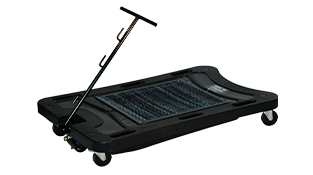The pressure to get more done with existing equipment has never been greater. With contractors often needing to push the limits of their existing fleets, downtime is not an option. In this environment, proactive preventive maintenance (PM) is essential for success.
Choosing the right mobile oil change equipment goes a long way toward achieving the desired outcome, keeping all PM of the fleet up to date. These days, there are a lot of great solutions on the market. Lube trucks are a great choice if you have enough PM work to maximize utilization and keep the dedicated truck working during the shift. Or, if you need both fuel and lube capabilities. Lube skids offer a flexible solution for servicing compact equipment and smaller fleets. Let’s not forget about lube trailers though. Lube trailers offer the capacity to keep up with larger fleets while also having the flexibility to optimize truck utilization with other tasks. So, who’s a good fit for a lube trailer? We’ll dig into this in more detail next.
Advantages of lube trailers
If your fleet requires more fluid capacity than lube skids can provide but you can’t justify a dedicated fuel and lube truck, lube trailers may prove the ideal solution. Lube trailers have larger tanks than skids and can carry more fluids (both fresh and used) while not requiring the use of a dedicated truck. Aside from what your PM needs are, determining the sweet spot for fluid capacity is typically determined by the tires, axles and capability of the truck used to pull it.
Budget is another important consideration when investing in any mobile oil change equipment and ensuring the equipment you choose maximizes ROI. With a lube trailer, the tow vehicle can be used to perform other tasks on the jobsite. Virtually any truck in your fleet with the appropriate GVWR can be used to move the trailer, including heavy-duty pickups and hitch-equipped heavy equipment. Plus, with a trailer, the truck’s bed space is still available.
“Lube trailers provide flexibility because you can simply unhitch them and use the truck for other tasks,” says Aaron Sage, CEO, Sage Oil Vac. “Also, if the tow vehicle breaks down, the trailer can be pulled by a different truck.”
For example, Houston-based Sprint Sand & Clay found running 200 pieces of equipment on multiple jobsites was more efficient with a dedicated lube truck. However, Texas-based Rabern Rentals didn’t have the same daily demands and was able to maximize efficiency with a lube trailer.
“With 500 gallons of fresh oil onboard [a Sage Oil Vac lube trailer], I can handle multiple services in a single trip and get rid of all the buckets I used to have to carry in the back of my truck,” said Tim Poland, service technician for Rabern Rentals.
Lube trailers also carry the advantage of being accessible. With larger dedicated lube trucks (Class 7 and above), service technicians must possess a commercial driver’s license (CDL) to operate. This limits the available labor pool in today’s competitive market. Sage Oil Vac offers solutions under the 26,000 GVWR threshold, in the form of non-CDL lube trucks, lube skids and a comprehensive lineup of lube trailers. These compact trailered systems can be pulled to and from the jobsite without a CDL with the right truck and trailer combination.
Why Sage Oil Vac lube trailers are more productive
Exclusive pump-free technology puts Sage Oil Vac lube trailers in a class of their own. Compared to traditional pump-based systems, our vacuum technology uses compressed air to move fluids into and out of tanks. A Sage Oil Vac system can vacuum fill fresh oil tanks at rates up to 15 gallons per minute, dispense products at up to 5 gallons a minute and vacuum hot motor oil at up to 8 gallons per minute. The result? More machines are serviced daily than possible with pump-driven models. No pumps mean less long-term maintenance and increased reliability.
The Sage Oil Vac pump-free process also uses sealed, non-vented tanks, which means contaminants stay out of the tanks and result in cleaner and safer oil changes.
Sage Oil Vac lube trailers come in both open and enclosed configurations and can be equipped with different tank sizes to accommodate the capacity needed. From our 380 PM trailer that offers 140 gallons of fluid capacity, to the 6220 jobsite trailer that packs a punch with a tandem-axle 13,000-pound gross vehicle weight rating (GVWR) trailer with 920 gallons of fluid capacity, we offer trailers equipped to meet the demands of your operation. Plus, a wide variety of configurations, accessories and available storage space sets service technicians up for success.
If you need more capacity than a lube skid and a flexible option that maximizes truck utilization, a lube trailer may be the ideal solution. Contact a Sage Oil Vac dealer to discuss how a lube trailer can increase PM flexibility — or explore our available inventory to see lube trailers available to ship right now.













